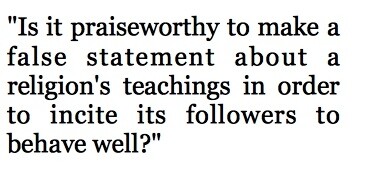Today a report appeared in The Australian, a national daily newspaper, which discussed forced marriages in our nation. There were many good points made in this article, which was entitled It is the young flesh they want.
However the article reported, as if it were true, a completely false and easily disprovable statement about the Koran.
The offending paragraph was:
It is true that the Koran does not refer specifically to child marriage. However in discussing divorce it does refer to conditions applying for a female who has not yet menstruated, i.e. for a pre-pubescent girl. The reference is found in Sura 65:4 in a list of regulations concerning the waiting period (the Iddah or Iddat) for divorced women before they can remarry. The verse deals systematically with different cases of women who for some reason are not having regular periods. It reads:
It might be thought that this verse is ambiguous in relation to young girls. However it is quite clear. It systematically covers the three main cases where a female is not menstruating: the old, the young, and those who are pregnant.
Ibn Kathir’s highly respected commentary on the Koran has this to say about this passage (see here).
The reference to ‘Surat Al-Baqarah’ is to Chapter 2 verse 228 of the Koran, which states that divorced women must wait through three menstrual periods before remarrying. Ibn Kathir also refers to two hadiths or traditions of Muhammad that Sura 65:4 was revealed when someone asked Muhammad about the young, the old and the pregnant, because their waiting period could not be determined from the principle of three menstrual periods, given in Sura 2: 228.
Furthermore, Islam is not just based upon the Koran. It is also based upon the example and teaching of Muhammad, and here there is very clear support for what today we would call ‘underage’ marriages, because Muhammad married Aisha when she was six and consummated this marriage when she was reported to have been nine years old (that is nine lunar years, which means she was aged somewhere between 8 years, nine months and 9 years, nine months). The revered Sahih al-Bukhari, a collection of sayings of Muhammad, includes a chapter with this heading:
This chapter consists of the following hadith:
Collections of hadiths are arranged for legal purposes. The heading of each chapter indicates the relevance of the hadiths it contains for jurisprudence. In this case, referencing Sura 65:4, a hadith about the marriage of Aisha is taken as evidence that it is permissible for a father to marry off his young daughters, specifically if she has not yet reached puberty.
I have written in Quadrant (here) about the rule in Islamic law that a father or a grandfather is considered to be a wali mujbir, or ‘forcing guardian’, who has the right to marry a virgin daughter without her permission.
What Jennifer Burn seems to be trying to do is entirely laudable. She seems to be attempting to persuade Muslim communities to reject forced marriages of female children. However to do so she claims that this practice is not supported by the Koran, which is quite false.
Is it praiseworthy to make a false statement about a religion’s teachings in order to incite its followers to behave well? Whatever the answer to this question may be, this strategy is bound to fail, because anyone who is better informed about the religion will simply reject advice based upon ignorance.
A strategy that acknowledges the authorities in Islam for a practice, and then mounts a case against the practice, is far more likely to have enduring success than one based upon wishful thinking or misleading information.
Mark Durie is a theologian, human rights activist, pastor of an Anglican church, a Shillman-Ginsburg Writing Fellow at the Middle East Forum, and director of the Institute for Spiritual Awareness. He has published many articles and books on the language and culture of the Acehnese, Christian-Muslim relations and religious freedom. A graduate of the Australian National University and the Australian College of Theology, he has held visiting appointments at the University of Leiden, MIT, UCLA and Stanford, and was elected a Fellow of the Australian Academy of the Humanities in 1992.








